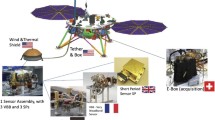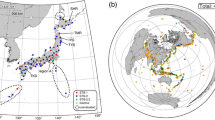Abstract
The midband sensitivity of a seismic instrument is one of the fundamental parameters used in published station metadata. Any errors in this value can compromise amplitude estimates in otherwise high-quality data. To estimate an upper bound in the uncertainty of the midband sensitivity for modern broadband instruments, we compare daily microseism (4- to 8-s period) amplitude ratios between the vertical components of colocated broadband sensors across the IRIS/USGS (network code IU) seismic network. We find that the mean of the 145,972 daily ratios used between 2002 and 2013 is 0.9895 with a standard deviation of 0.0231. This suggests that the ratio between instruments shows a small bias and considerable scatter. We also find that these ratios follow a standard normal distribution (R 2 = 0.95442), which suggests that the midband sensitivity of an instrument has an error of no greater than ±6 % with a 99 % confidence interval. This gives an upper bound on the precision to which we know the sensitivity of a fielded instrument.










Similar content being viewed by others
References
Anderson K, Willemann RJ, Simpson DW (2011) Modernization of instrumentation of the Global Seismographic Network, 2011 Monitoring research review: ground-based nuclear explosion monitoring technologies, 408–413
Aster RC, Borchers B, Thurber CH (2005) Parameter estimation and inverse problems. Elsevier, London
Aster RC, McNamara DE, Bromirski PD (2010) Global trends in extremal microseism intensity. Geophys Res Lett. doi:10.1029/2010GL043472
Beyreuther M, Barsch R, Krischer L, Megies T, Behr Y, Wassermann J (2010) ObsPy: a python toolbox for seismology. Seismol Res Lett 81:530–533
Butler R, Creager K, Earl P, Fischer K, Gaherty J, Laske G, Leith W, Park J, Ritzwoller M, Tromp J, Wen W (2004) The Global Seismographic Network surpasses its design goal. Eos Trans AGU 85:225–232
Davis P, Berger J (2007) Calibration of the Global Seismographic Network using tides. Seismol Res Lett 78:454–459
Davis P, Berger J (2012) Initial impact of the Global Seismographic Network quality initiative on metadata accuracy. Seismol Res Lett 83:697–703
Davis P, Ishii M, Masters G (2005) An assessment of the accuracy of GSN sensor response information. Seismol Res Lett 76:678–683
Ekstrom G, Dalton CA, Nettles M (2006) Observations of time-dependent errors in long-period instrument gain at global seismic stations. Seismol Res Lett 77:12–22
Hayes G, Earle PS, Benz HM, Wald DJ, Briggs RW (2011) 88 hours: the U.S. Geological Survey National Earthquake Information Center response to the 11 March 2011 Mw=9.0 Tohoku earthquake. Seismol Res Lett 82:481–493
Hutt CR, Ringler AT (2011) Some possible causes and corrections for STS-1 response changes in the Global Seismographic Network. Seismol Res Lett 82:560–571
IDA, and USGS (2010) GSN Calibration, http://www.iris.edu/hq/files/programs/gsn/gsnqual/GSN_20calibration_20summary.v8.pdf. Last Accessed Sept 2014
Richards PG, Kim W-Y (2005) Equivalent volume sources for explosions at depth: theory and observations. Bull Seismol Soc Am 95:401–407
Ringler AT, Hutt CR (2010) Self-noise models of seismic instruments. Seismol Res Lett 81:972–983
Ringler AT, Gee LS, Hutt CR, McNamara DE (2010) Temporal variations in global seismic station ambient noise power levels. Seismol Res Lett 81:605–613
Ringler AT, Hutt CR, Aster R, Bolton H, Gee LS, Strom T (2012) Estimating pole/zero errors in GSN-IRIS/USGS network calibration metadata. Bull Seismol Soc Am 102:836–841
Ringler AT, Hutt CR, Persefield K, Gee LS (2013) Seismic station installation orientation errors at ANSS and IRIS/USGS stations. Seismol Res Lett 84:926–931
Scherbaum F (2006) Of poles and zeros: fundamentals of digital seismology. Springer, Dordrecht
Widmer R, Master G, Freeman G (1991) Spherically symmetric attenuation within the Earth from normal mode data. Geophys J Int 104:541–553
Wielandt E, Steim J (1986) A digital very broad band seismograph. Ann Geophys 4:227–232
Acknowledgments
We thank Luciana Astiz, Thomas Braun, Hunter Knox, Jill McCarthy, Janet Slate, Valerie Thomas, and two anonymous reviewers for their helpful reviews that ultimately improved the content and presentation of this manuscript. We also thank Tom VanZandt for useful discussions regarding some of the phenomena related to linear drift.
The Global Seismographic Network (GSN) is a cooperative scientific facility operated jointly by the Incorporated Research Institutions for Seismology (IRIS), the U.S. Geological Survey (USGS), and the National Science Foundation (NSF). Any use of trade, product, or firm names is for descriptive purposes only and does not imply endorsement by the U.S. Government.
Author information
Authors and Affiliations
Corresponding author
Rights and permissions
About this article
Cite this article
Ringler, A.T., Storm, T., Gee, L.S. et al. Uncertainty estimates in broadband seismometer sensitivities using microseisms. J Seismol 19, 317–327 (2015). https://doi.org/10.1007/s10950-014-9467-7
Received:
Accepted:
Published:
Issue Date:
DOI: https://doi.org/10.1007/s10950-014-9467-7




